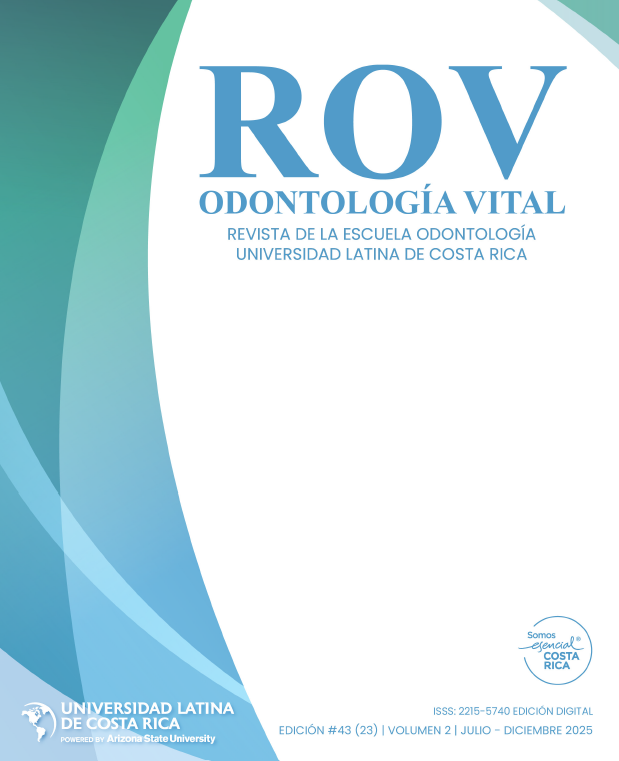Analysis and Evaluation of Nasal Angles in Non-Surgical Rhinoplasty with Hyaluronic Acid
DOI:
https://doi.org/10.59334/ROV.v2i43.666Keywords:
hyaluronic acid, nasal remodeling, non-surgical rhinoplasty, nasolabial angle, facial profile analysisAbstract
Background: Studies show the efficacy and safety of nasal reshaping with hyaluronic acid. However, there is little evidence on the clinical parameters modified to achieve an aesthetic improvement in the nasal profile. In aesthetic analysis, the nasolabial angle has often been used to evaluate the rotation of the nasal tip in non-surgical rhinoplasty, a parameter dependent on the position of the upper lip. The researchers declare no conflicts of interest. Objective: The purpose of this study is to demonstrate the changes induced by non-surgical rhinomodelling in the nasal profile by measuring the nasolabial angle traced on soft tissues and the new nasal angle proposed by the authors. Additionally, the study highlights the efficacy and safety of nasal reshaping with hyaluronic acid. Methods: This is a prospective open-label study where the outcome of rhinoplasty treatment with cannula (23G x 38 mm) was evaluated in 25 adult patients (treated in the areas of the nasal spine, columella, and supratip) using a maximum of 0,6 ml of hyaluronic acid. Results: Twenty-five patients participated in this study (22 women and 3 men) with an average age of 34 years. An average of 0.33 ± 0.11 ml of hyaluronic acid was infiltrated during the procedure. Twenty-two patients underwent this procedure for the first time during this study, while the other three had undergone between 1 to 3 previous procedures. Only two patients required a second intervention, using an average of 0.18 ml. Nasolabial angles before and after treatment were measured; on average, this increased from 89.3 ± 11.3° to 98.4 ± 8.2° (average change of 9.1 ± 7.3°). No complications were recorde. Conclusion: Statistically significant changes were observed when comparing the nasolabial angle measurements before and after the procedure, with an average increase of 9º, as determined through nasal profile analysis and subsequently tested in STATA 11 (P=0.0000). Additionally, given that the nasolabial angle may vary due to aging and modifications in perioral structures, it is necessary to measure another angle to assess nasal tip projection.
Downloads
References
Akinbiyi, T., Othman, S., Familusi, O., Calvert, C., Card, E. B., & Percec, I. (2020). Better Results in Facial Rejuvenation with Fillers. In Plastic and Reconstructive Surgery - Global Open (Vol. 8, Issue 10, p. E2763). Lippincott Williams and Wilkins. https://doi.org/10.1097/GOX.0000000000002763
Alshawaf, S. M., McGuire, C., ElAbd, R., Fakih-Gomez, N., Williams, J., AlYouha, S., & Samargandi, O. A. (2024). Preferred Nasolabial Angle in Rhinoplasty: A Cross-Sectional Analysis. Aesthetic Surgery Journal, 44(3), 275–285. https://doi.org/10.1093/asj/sjad309
American Society of Plastic Surgeon. (2021). The centerpiece of the face: Why nonsurgical rhinoplasties are gaining popularity | ASPS. https://www.plasticsurgery.org/news/articles/the-centerpiece-of-the-face-why-nonsurgical-rhinoplasties-are-gaining-popularity
American Society of Plastic Surgeon. (2022). 2022 ASPS Procedural Statistics Release. In Plastic and reconstructive surgery (Vol. 1, Issue 1). https://doi.org/10.1097/PRS.0000000000011235
Bertossi, D., Giampaoli, G., Verner, I., Pirayesh, A., Nocini, R., & Nocini, P. (2019). Complications and management after a nonsurgical rhinoplasty: A literature review. Dermatologic Therapy, 32(4), 1–8. https://doi.org/10.1111/dth.12978
Bertossi, D., Magagnotto, N., Chirumbolo, S., D’Souza, A., & Nocini, R. (2022). Nonsurgical Rhinoplasty: Long-Term Follow-Up of High G′ HA Nasal Injections. Facial Plastic Surgery, 38(2), 96–101. https://doi.org/10.1055/s-0042-1742431
DeVictor, S., Ong, A. A., & Sherris, D. A. (2021). Complications Secondary to Nonsurgical Rhinoplasty: A Systematic Review and Meta-analysis. In Otolaryngology - Head and Neck Surgery (United States) (Vol. 165, Issue 5, pp. 611–616). John Wiley & Sons, Ltd. https://doi.org/10.1177/0194599820987827
Frédéric, B., Philippe, K., Jérôme, P., & Florian, N. (2023). Concepts and principles of medical rhinoplasty. Journal of Dermatology & Cosmetology, 7(4), 158–163. https://doi.org/10.15406/jdc.2023.07.00254
Helal, H. A., Ghanem, M. A. M., Al-Badawy, A. M., Abdel Haleem, M. M., & Mousa, M. H. (2019). Histological and Anthropometric Changes in the Aging Nose. Aesthetic Surgery Journal, 39(9), 943–952. https://doi.org/10.1093/ASJ/SJY245
Kumar, V., Jain, A., Atre, S., Shome, D., Kapoor, R., Doshi, K., & Vadera, S. (2021). Non-surgical rhinoplasty using hyaluronic acid dermal fillers: A systematic review. Journal of Cosmetic Dermatology, 20(8), 2414–2424. https://doi.org/10.1111/jocd.14173
Youn, S. H., & Seo, K. K. (2016). Filler Rhinoplasty Evaluated by Anthropometric Analysis. Dermatologic Surgery, 42(9), 1071–1081. https://doi.org/10.1097/DSS.0000000000000832
Downloads
Published
License
Copyright (c) 2025 Paula Arroyo A., Isidora Belén Contreras Rojas, Javier Rojo Pereira, Rodrigo Hernández Quezada

This work is licensed under a Creative Commons Attribution 4.0 International License.
Authors who publish with Odontología Vital agree to the following terms:
- Authors retain the copyright and grant Universidad Latina de Costa Rica the right of first publication, with the work simultaneously licensed under a Creative Commons Attribution 4.0 International license (CC BY 4.0) that allows others to share the work with an acknowledgement of the work's authorship and initial publication in this journal.
- Authors are able to enter into separate, additional contractual arrangements for the non-exclusive distribution of the Odontología Vital's published version of the work (e.g., post it to an institutional repository or publish it in a book), with an acknowledgement of its initial publication.
- Authors are permitted and encouraged to post their work online (e.g., in institutional repositories or on their website) prior to and during the submission process, as it can lead to productive exchanges, as well as earlier and greater citation of published work.







